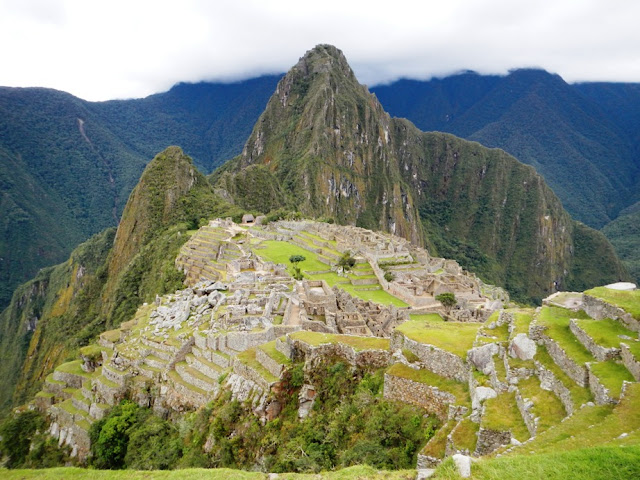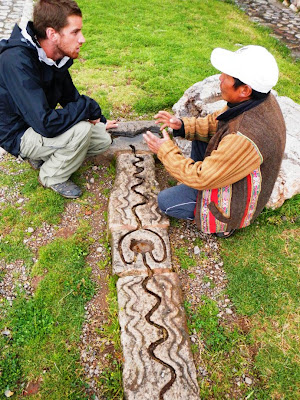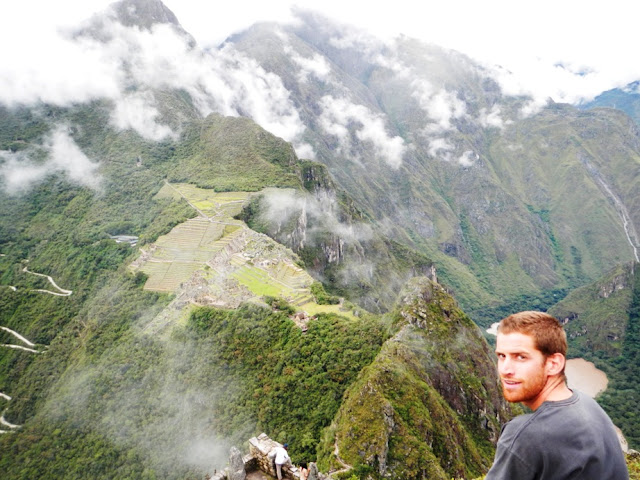 |
| Streets of Cuzco |
Before leaving Arica we met up with two travelers from Germany that were surfing and camping their way through South America. We decided to cross into Peru with them, and maybe convoy to our next stop. Prior to entering a country in S.A. you must first exit out of the country you are currently in (in our case Chile). We have had no problems with this process in the past crossing through into Argentina and back again. However, on this occasion at this particular boarder they refused to let us exit Chile because apparently to travel with a Chilean vehicle into Peru we needed to be Chilean residents. Technically, we had the paper work, a RUT (similar to a social insurance number), but it was a paper copy only valid for a short time. The old-timer boss told us all we needed to do was get a new temporary RUT that was valid for a longer period. The next day we got our new paper, headed back to the boarder and got rejected outright again. We found the boss working that day, and he said it was impossible for us to cross here but maybe we could get through by the nearby Bolivian boarder. Feeling bummed and defeated we contemplated what to do next, but thought we would go back once more to get clarification on what exactly the problem was.
 |
| Ninos Hotel |
It seemed a little strange that although we weren’t Chileans, and couldn’t cross into Peru that we could cross over into Bolivia. To our good fortune, we spotted a grandfatherly looking man and thought he could be our guy—and he was! He had to argue with a few adamant Chilean aduana’s officers, but when all was said and done we were granted with permission to get the heck out of Chile.
We decided to go to Arequipa for the night since Cusco was too far a journey and we’d be arriving late. Although this seemed like a great idea, its Peru’s rainy season and we ended up getting a little more than a smooth drive into the city. Torrential rain was pouring down and we ended up having to take an alternative route into the city. It turned out the river before entering the city had flooded and buses were wheel well deep in water. In turn, this backed up traffic from 10 km away and it took about 3 hours to inch our way forward. In the end we couldn’t even cross, but were told we could use a back road. We followed a few other able vehicles up this dark and road but made it in.
 |
| Ninos Library |
The following day we hit the road early for Cusco. This turned into another long day of driving, but we managed fine and took in the new landscape and had already decided Peru was going to a fantastic part of the trip. That night we stayed at
http://www.ninoshotel.com. Owner Jolanada van den Berg is doing some amazing things from the profits of the hotel for local children. The profits from the hotel help fund a program designed to feed and foster 600 ninos between the ages 6-12. In addition, 80 Peruvians are employed at the various centres and other ninos hotels in the area that support the same project. The next day we were able to visit the centre and find out more about the poverty which has been uncomfortable and challenging. I think there is something to this raw grittiness that holds an undeniable truth that most of us don’t want to acknowledge. The poverty is ubiquitous, but while we sympathize from a distance, it is very easy to ignore everyone, acknowledge no one and constantly remain on guard believing that we will be swindled or bamboozled if we pay the slightest attention. Our personal solution to providing something without contributing through monetary means has been by 1) engaging in conversation and always trying our best in spanish 2) showing gratitude and respect and 3) giving food away when it seems appropriate. We’ve also decided to call out other tourists we see doing things that are rude and who are lacking common courtesy. We saw a bit of this in Cusco from the wealthy, flashy people who in our opinion were pretty much asking for trouble showcasing their affluence and bad attitudes. Cusco is known to be a bit of a rough town for tourists and there is no question why with the high-rollers wandering the plaza.
 |
| Sacsaywaman |
 |
| Sacsaywaman |
 |
| Water Works |
 |
| Ollantaytambo terraces |
After we got tickets for the train ride to Machu Picchu and entrance tickets into the park we left for Ollantaytambo . We checked out the Sacsaywaman ruins along the way and stopped by Pisac for their renowned market. We left Ollantaytambo the following night for Machu Pichu, but high rains that caused a landside of rocks to cross the tracks meant a 3 hour delay. We only got a few hours of sleep that night at Aguas Caliente (elevation 8000ft) and left at 6 am for the hike up to site. It turned out be more grueling and hot than expected and Iain was shirtless in the first 20 minutes. This part of the Machu Picchu experience turned out to be the most physically demanding! Highlights of the day included: a) Wayna Picchu b) the sun dial (radiating energy from the quartz inside the granite) c) the condor d) the Inca bridge e) petting llamas and f) all ruins in general.
+of+DSCN1422.JPG) |
| Machu Picchu Baby |
 |
| MP Local |
 |
| Moray Terraces, 20 micro-climates used for agriculture experimentation |
 |
| Moray Watering System |
After our full day of exploring we spent the night in Ollantaytambo and the next day checked out ruins around Moray and went back to Pisac. We’ve taken in more ruins here and the enormous/famous market one more time for spectacular textiles and art. We plan to head back to Cusco tomorrow to do a load of laundry and check out some museums with our boleto touristico.
p.s. our apologies for the lack of mechanical entertainment regarding our car—apparently our car enjoys the high altitude of the Peruvian Andes and we haven’t broken down since our last post J
 |
| Valentine's Day in the Sacred Valley |
 |
| Dreams Do Come True!! |
 |
| Stone Compass |
 |
| This is the result of being the only tourists in the market |
 |
| Quechuan friend/guide |

 |
| View from Wayna Picchu |
 |
| Inca Face in the Mountain |
 |
| Insane River Below Machu Picchu |




















+of+DSCN1422.JPG)














No comments:
Post a Comment